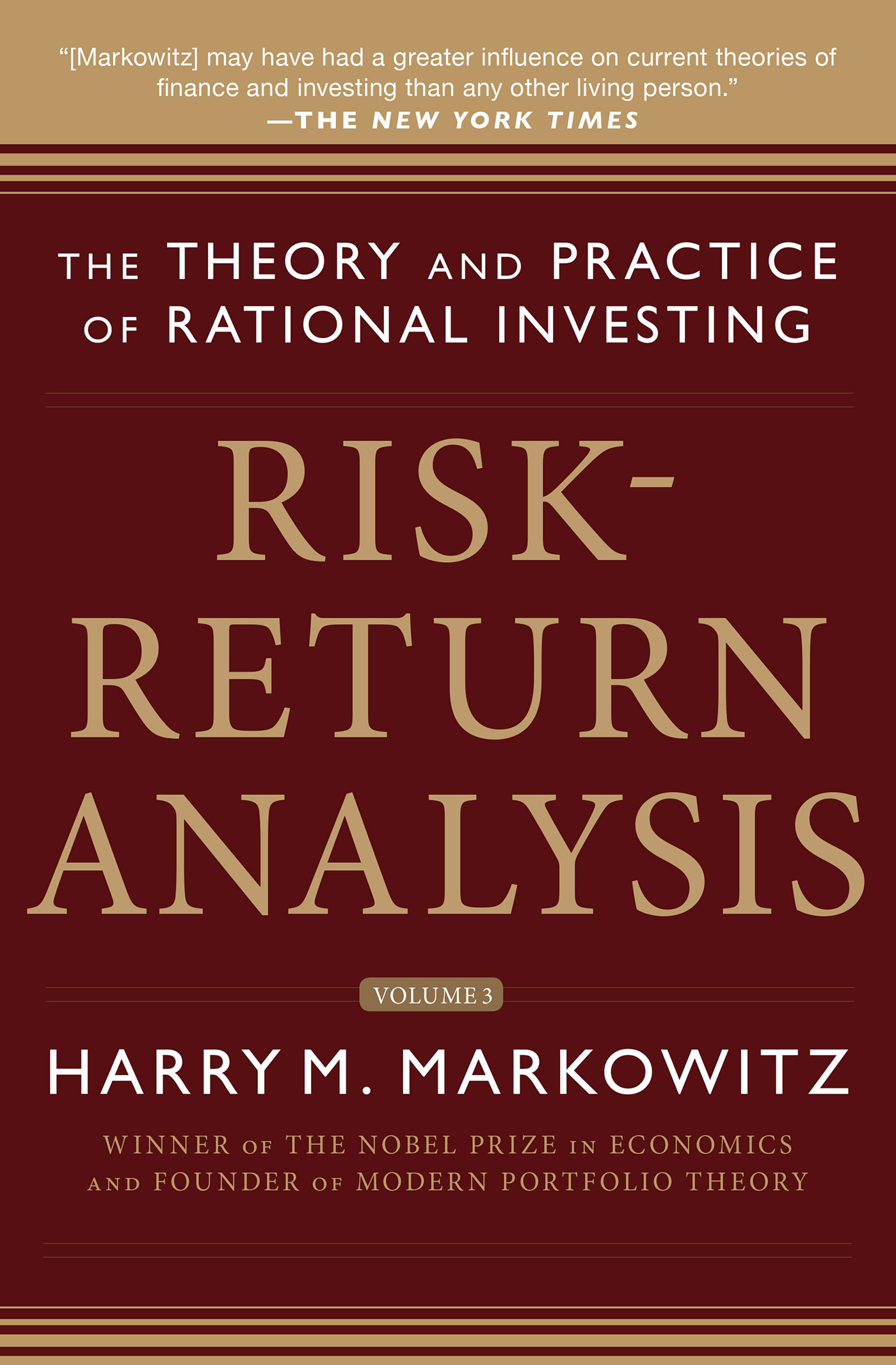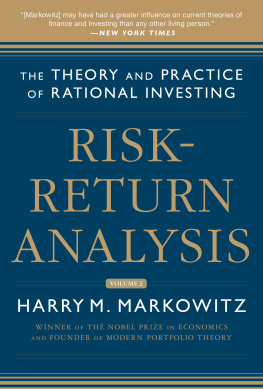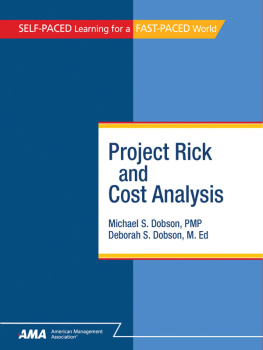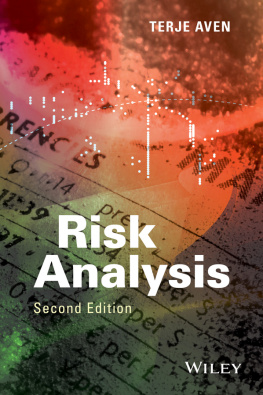Harry M. Markowitz - Risk-Return Analysis, Volume 3
Here you can read online Harry M. Markowitz - Risk-Return Analysis, Volume 3 full text of the book (entire story) in english for free. Download pdf and epub, get meaning, cover and reviews about this ebook. year: 2020, publisher: McGraw-Hill Education, genre: Romance novel. Description of the work, (preface) as well as reviews are available. Best literature library LitArk.com created for fans of good reading and offers a wide selection of genres:
Romance novel
Science fiction
Adventure
Detective
Science
History
Home and family
Prose
Art
Politics
Computer
Non-fiction
Religion
Business
Children
Humor
Choose a favorite category and find really read worthwhile books. Enjoy immersion in the world of imagination, feel the emotions of the characters or learn something new for yourself, make an fascinating discovery.

- Book:Risk-Return Analysis, Volume 3
- Author:
- Publisher:McGraw-Hill Education
- Genre:
- Year:2020
- Rating:4 / 5
- Favourites:Add to favourites
- Your mark:
- 80
- 1
- 2
- 3
- 4
- 5
Risk-Return Analysis, Volume 3: summary, description and annotation
We offer to read an annotation, description, summary or preface (depends on what the author of the book "Risk-Return Analysis, Volume 3" wrote himself). If you haven't found the necessary information about the book — write in the comments, we will try to find it.
Risk-Return Analysis, Volume 3 — read online for free the complete book (whole text) full work
Below is the text of the book, divided by pages. System saving the place of the last page read, allows you to conveniently read the book "Risk-Return Analysis, Volume 3" online for free, without having to search again every time where you left off. Put a bookmark, and you can go to the page where you finished reading at any time.
Font size:
Interval:
Bookmark:


Copyright 2020 by Harry M. Markowitz. All rights reserved. Except as permitted under the United States Copyright Act of 1976, no part of this publication may be reproduced or distributed in any form or by any means, or stored in a database or retrieval system, without the prior written permission of the publisher.
ISBN: 978-0-07-181833-9
MHID: 0-07-181833-2
The material in this eBook also appears in the print version of this title: ISBN: 978-0-07-181831-5, MHID: 0-07-181831-6.
eBook conversion by codeMantra
Version 1.0
All trademarks are trademarks of their respective owners. Rather than put a trademark symbol after every occurrence of a trademarked name, we use names in an editorial fashion only, and to the benefit of the trademark owner, with no intention of infringement of the trademark. Where such designations appear in this book, they have been printed with initial caps.
McGraw-Hill Education eBooks are available at special quantity discounts to use as premiums and sales promotions or for use in corporate training programs. To contact a representative, please visit the Contact Us page at www.mhprofessional.com.
This publication is designed to provide accurate and authoritative information in regard to the subject matter covered. It is sold with the understanding that neither the author nor the publisher is engaged in rendering legal, accounting, securities trading, or other professional services. If legal advice or other expert assistance is required, the services of a competent professional person should be sought.
From a Declaration of Principles Jointly Adopted by a Committee of the American Bar Association and a Committee of Publishers and Associations
TERMS OF USE
This is a copyrighted work and McGraw-Hill Education and its licensors reserve all rights in and to the work. Use of this work is subject to these terms. Except as permitted under the Copyright Act of 1976 and the right to store and retrieve one copy of the work, you may not decompile, disassemble, reverse engineer, reproduce, modify, create derivative works based upon, transmit, distribute, disseminate, sell, publish or sublicense the work or any part of it without McGraw-Hill Educations prior consent. You may use the work for your own noncommercial and personal use; any other use of the work is strictly prohibited. Your right to use the work may be terminated if you fail to comply with these terms.
THE WORK IS PROVIDED AS IS. McGRAW-HILL EDUCATION AND ITS LICENSORS MAKE NO GUARANTEES OR WARRANTIES AS TO THE ACCURACY, ADEQUACY OR COMPLETENESS OF OR RESULTS TO BE OBTAINED FROM USING THE WORK, INCLUDING ANY INFORMATION THAT CAN BE ACCESSED THROUGH THE WORK VIA HYPERLINK OR OTHERWISE, AND EXPRESSLY DISCLAIM ANY WARRANTY, EXPRESS OR IMPLIED, INCLUDING BUT NOT LIMITED TO IMPLIED WARRANTIES OF MERCHANTABILITY OR FITNESS FOR A PARTICULAR PURPOSE. McGraw-Hill Education and its licensors do not warrant or guarantee that the functions contained in the work will meet your requirements or that its operation will be uninterrupted or error free. Neither McGraw-Hill Education nor its licensors shall be liable to you or anyone else for any inaccuracy, error or omission, regardless of cause, in the work or for any damages resulting therefrom. McGraw-Hill Education has no responsibility for the content of any information accessed through the work. Under no circumstances shall McGraw-Hill Education and/or its licensors be liable for any indirect, incidental, special, punitive, consequential or similar damages that result from the use of or inability to use the work, even if any of them has been advised of the possibility of such damages. This limitation of liability shall apply to any claim or cause whatsoever whether such claim or cause arises in contract, tort or otherwise.
[T]he race is not to the swift, nor the battle to the strong, neither yet bread to the wise, nor yet riches to men of understanding, nor yet favour to men of skill; but time and chance happeneth to them all.
Ecclesiastes 9:11
Excuse me sir, but
How much longer would it take
If we did it right
The first time?
Harry Max Markowitz
Lifes tragedy is that
We get old too soon
And wise too late.
Benjamin Franklin
If not now, when?
If not me, who?
Hillel, the Elder
T his third volume of a four-volume book, Risk-Return Analysis: The Theory and Practice of Rational Investing, begins with on its own so that interested readers could begin the study of its contents.
As explained in the prefatory material of Volume I, the topics of the four volumes parallel the topics of the last four chapters of Markowitz (1959). Specifically, Volume I considers single-period decision analyses assuming known odds as did Markowitz (1959) Chapter 10. Volume II considers many-period analyses, still assuming known odds, as did Markowitz (1959) Chapter 11. The present volume is concerned with rational decision-making in the face of uncertainty, i.e., when odds are not known, as did Markowitz (1959) Chapter 12. The fourth volume will cover application matters not covered, or not adequately covered, in the prior three volumes. The chief difference between was written a priori, when the world had no experience with the practical application of MVA (Mean Variance Analysis), whereas Volume IV of the present book is based on over a half-century of MVA experience.
Each volume of this book distinguishes between the actions of a hypothetical Rational Decision Maker (RDM) and those of a Human Decision Maker (HDM). Our focus is on rationali.e., RDMaction, and HDM approximations to it. The reason that the HDM makes an appearance in these volumes at all, is because (as the subtitle of this book promises) the book deals with practice as well as theory. I do not mean by this the questionable practices documented in behavioral studies such as that of Odean (1999) or McKay (2013, 1841). Rather, I mean existing and proposed HDM practices that seek to emulate the behavior, and approximate the results, of the RDM. Discussions of this sort are scattered throughout the volumes of this book, including, but not only, Chapter 11 in Volume II, on Judgment and Approximation.
The RDM is a fictitious creation. Like other fictitious creationssuch as the unicorn, or the fictional as opposed to the historical St. Nicholaseach storyteller can ascribe to it whatever attributes his or her audience can be persuaded are appropriate for the entity. The RDM of Mossin and Samuelson, discussed in Chapter 9, is a solitary investor. As Chapter 6 (in Volume II) spelled out in some detail, my RDM can be an individual (of either gender of course), a family, or an institution such as a university or symphony orchestra.
As a specific example, the frontice material of Volume II introduced a prototypical RDM as a family with husband, wife, four children, a dog, and a catall rational. But, as Markowitz (1959) emphasized, a rational entity is neither omniscient nor omnipotent. In particular, the rational cat cannot catch the irrational rat. This is perfectly plausible despite the fact that a hungry natural cat can eventually catch some natural rat. Presumably, our rationalbut fussy, of coursecat would prefer to finish the tuna in its bowl than to eat a raw rat. Its moves toward catching the rat are perfunctory. Perhaps the Rational Cat (RC) does not really want to catch the Irrational Rat (IR) because it is a clean and sanitary white ratsaved by RCs good-hearted family from its fate in a research lab. Perhaps playing cat and mouse with IR is RCs only entertainment when the humanoid RDMs are out for the day, and either the RC or the Rational Dog (RD) is tired of playing hide and seek.
Font size:
Interval:
Bookmark:
Similar books «Risk-Return Analysis, Volume 3»
Look at similar books to Risk-Return Analysis, Volume 3. We have selected literature similar in name and meaning in the hope of providing readers with more options to find new, interesting, not yet read works.
Discussion, reviews of the book Risk-Return Analysis, Volume 3 and just readers' own opinions. Leave your comments, write what you think about the work, its meaning or the main characters. Specify what exactly you liked and what you didn't like, and why you think so.








